“Creating and marketing value-added products has the potential to significantly enhance our farm's profitability, but this is no easy task. Our value-added funds will help pay for processing, marketing, distribution, and sales of our pasture-raised chickens and eggs, as well as microgreens that we grow,” said Alex McKiernan, co-owner of Robinette Farms near Lincoln, Nebraska. The farm received a working capital grant in 2015.
Robinette Farms is now packaging and selling microgreens at local grocery stores, often partnering with a distributor and offering tastings to shoppers. Without the assistance of the Value-Added Producer Grants (VAPG) program, it would be difficult for small farming operations like Robinette Farms to develop new products and access higher-value markets.
What is the opportunity?
On Monday, Aug. 28, 2017, U.S. Department of Agriculture (USDA) announced the availability of at least $18 million in funding through the competitive VAPG program.
Administered by USDA Rural Development, the VAPG program provides competitive grants to producers for working capital, feasibility studies, business plans, and marketing efforts used to establish value-added businesses. Up to $75,000 is available for a planning grant, and up to $250,000 is available for an implementation grant. Value-added grants can be used to develop new product lines from raw agricultural products or to promote additional uses for established products.
Who is eligible?
Independent producers, agricultural producer groups, farmer or rancher cooperatives, and majority-controlled, producer-based business ventures are all eligible to apply for these grants.
The program prioritizes funding for applicants who are beginning, veteran farmers and ranchers, or socially-disadvantaged farmers and ranchers; operators of small- and medium-sized family farms and ranches; farmer and rancher cooperatives; and majority-controlled, producer-based business ventures whose projects “best contribute” to creating or increasing marketing opportunities for the aforementioned groups of farmers.
New this year, there are reserved funds for applications that support opportunities for beginning and socially-disadvantaged farmers and ranchers, and for proposed projects that develop mid-tier value marketing chains, as well as projects located in persistent poverty counties.
Who else has received VAPG funds?
William Powers, who owns and operates Darby Springs Farm in Ceresco, Nebraska, alongside his wife, Crystal, was another recipient of a $50,000 VAPG in 2015. The federal money helped finance construction of a creamery that allows them to make and sell ice cream using milk from their pasture-grazed dairy cows.
“The program is crucial for young entrepreneurs with a cash-flow situation,” William told Huffington Post in a recent interview. “We’re not independently wealthy, so that grant helped us make up some of those upfront payments.”
Darby Springs opened the doors of their microcreamery in August 2017, offering tours and tastings of the ice cream they now make and sell.
Why should I apply?
Nicole Saville, co-owner and operator of Spiritus Vitae Botanicals, a small medicinal herb farm located outside of Lincoln, Nebraska, is eyeing the working capital grant, as well, to assist with marketing and other costs.
“I believe the funding will help us become better at what we love to do, while allowing us the opportunity to get our products into the hands of more people in southeast Nebraska,” she said.
Kathy, who runs a garden to market business with her husband outside of Stanton, Nebraska, was surprised to learn that she could apply for funds. The money could help the business owners better prepare for their local farmers market by funding business supplies, such as a tent, and marketing items, like brochures.
She started off with making jams and jellies from excess produce in the garden. But, after attending a few sessions of the Center’s Rural Food Business Growth project, Kathy told us that she began to learn more and visualize “the bigger picture.”
“Being awarded this grant would give us a boost,” she said. “We could have a real presence at the market, and when I called Rural Development to ask questions, they helped me figure out what I needed most.”
How do I apply?
The best way to get started is to contact your local Rural Development office: rd.usda.gov/contact-us/state-offices
This year’s notice included an extended application period to allow farmers and ranchers time to put together high-quality proposals before and after their busy harvest seasons.
The deadline to submit paper applications is Jan. 31, 2018, and the deadline to submit electronic applications is Jan. 24, 2018. Electronic applications must be submitted through grants.gov.
Additional resources:
The National Sustainable Agriculture Coalition is currently updating their “Farmer’s Guide to Applying for VAPG” and will possibly offer a webinar again this year. Stay tuned for details on their blog.
Nebraska 2015 VAPG program recipients can be found here.
Feature photo: Crystal Powers, co-owner and co-operator of Darby Springs Farm near Ceresco, Nebraska, gives a tour of the microcreamery in August. She and her husband, William, received a $50,000 value-added grant in 2015 to help finance construction of the building. The building features a walk-through milking station and three separate rooms - one for milk, one for ice cream, and one for a store.





